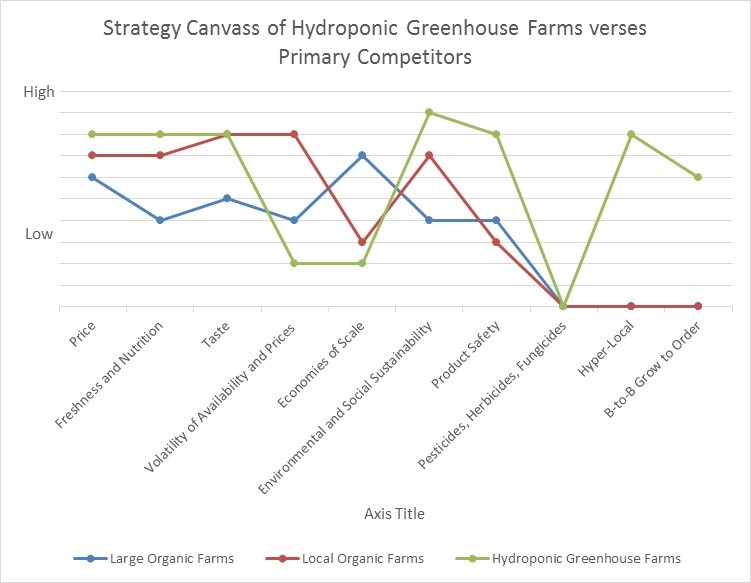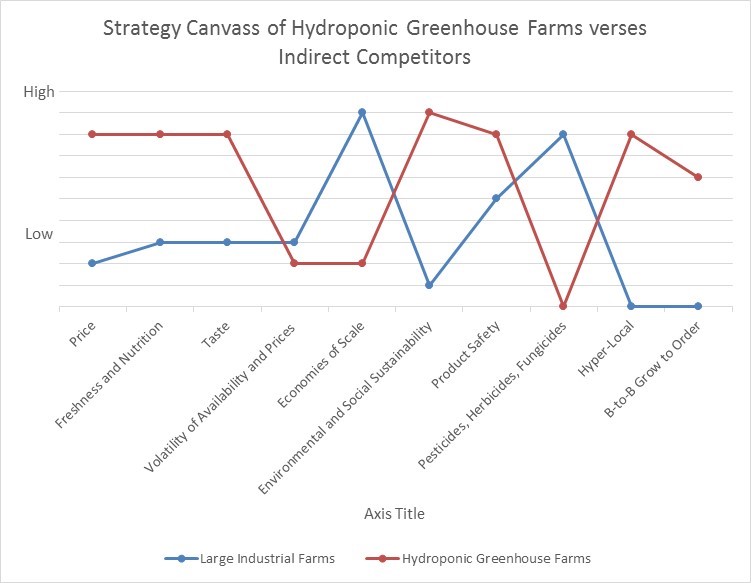Part 2: Discovering a Value Innovation "Blue Ocean" Idea

According to Kim and Mauborgne’s seminal business strategy book Blue Ocean Strategy, for an entrepreneur to discover a Blue Ocean idea, he or she must follow the four steps below:
1. Explore the six paths to creating Blue Oceans: Identify the current factors of competition for the industry or market you decide to explore. Create a strategy canvasses that reflects the factors of competition for current potential competitors’ value propositions.
2. Observe the distinctive advantages and disadvantages of potential competitors’ value propositions. Analyze the factors above and decide which of them should be raised, lowered, created or eliminated. All four actions must take place.
3. Construct a new strategy canvass that includes:
- The current value propositions offered by existing firms identified in Step 1 and Step 2
- Your proposed value proposition from Step 2 that raises, lowers, creates and eliminates the factors of competition.
4. Create a Blue Ocean strategy by ensuring the strategy canvas from Step 3 is:
- Focused (certain competitive factors are emphasized while others are deemphasized or eliminated)
- There is divergence (the strategic profiles between your value proposition and the value propositions of current market competitors are meaningfully and measurably different), and
- You have a compelling tagline that sums up your value proposition truthfully and succinctly [4]
I recognize that the above probably sounds like gobbledygook. So, I will try to break it down shotgun style for you!
We will analyze what each step entails by examining:
- The current market and industry for fresh fruits and vegetables and
- The Blue Ocean strategy of using hydroponic greenhouses to produce locally grown and sold fresh fruits and vegetables.
Granted, it’s a bit of a hippy business model. But I am writing this while sitting in a coffee shop in Seattle, so work with me people…
Step 1: Create a Strategy Canvass of Current and Potential Competitors
To measure a concept’s potential to create value innovation, the business idea must have elements (or factors) of both buyer value and cost savings [5]
Determining the key factors of competition among current or potential competitors is critically important in creating a successful Blue Ocean strategy.
The following is a list of the key competitive factors in the fresh fruit and vegetable industry that determine both buyers’ perceived value and cost savings.
- Affordability – The quantity of product that can be purchased by a buyer for a fixed price.
- Freshness and Nutrition – How recently harvested and ready for consumption the products appear. The nutritional value of the products are highest when most fresh.
- Taste – How delicious and flavorful the products are.
- Product Safety – The likelihood the product is free of bacteria that cause food-borne illnesses.
- Economies of Scale – Per unit production cost efficiencies gained through mass production and distribution.
- Pesticides, Herbicides, Fungicides – These products are used to control insects and food parasites.
- Product Shelf Life – How long the product will stay edible and fresh for the retailer or end customer.
- Volatility of Availability and Prices – The volatility in seasonal availability and costs incurred getting the products to market.
- Environmental and Social Sustainability – The relative degree to which the product consumes finite environmental resources and/or contributes to global warming. The product is considered more socially sustainable if it is “locally grown” – produced within 100 miles of the retailer or consumer.

The strategy map above describes the current key factors of competition of what is essentially a 10,000-year-old business model – plant agriculture.
The business model is simple:
- You plant fruits and vegetables in the ground in an organized manner
- You nurture and grow them till they are ready for harvest, and
- Then you sell (or trade) them to other people. Its an amazingly durable concept.
Step 2: Analyze the Factors – Raise, Lower, Create or Eliminate
To create a successful Blue Ocean strategy, you must break the value-cost trade off by either:
- Creating or recombining new markets and/or
- Pursuing both differentiation and low cost.
Step 2 is critical for prioritizing what factors the business will concentrate on and which ones it will ignore or eliminate. For example, hydroponic greenhouses that sell locally produced fresh fruits and vegetables will raise, lower, create or eliminate the following [6]

Factors Created:
- Hyper-Local – Where the maximum distance between where the products are produced and consumed is 30 miles.
- B-B Buyer Order to Grow – This feature allows LocalFarmer’s B-B buyers to place custom orders for specific crops to be grown to include the order size and harvest time.
Now, apply the factors raised, lowered, created or eliminated in Step 2 to the initial industry strategy canvass in Step 1. The purpose of this is to visually represent how the hypothetical Blue Ocean strategy created in Step 2 interacts with the current competitive structure in the target industry or market.
I decided to compare the direct and indirect competitors to the business concept I am analyzing (fruits and vegetables produced in hydroponic greenhouses) in two separate graphs below. I did this for two reasons. The first reason is practical - I think it reduces visual clutter. The second reason is that it separate graphs allow us to focus specifically on:
- The direct market we think we are shooting for,
- The tangential markets we might also service.
In the graph below, I have examined locally produced fruits and vegetables grown in hydroponic greenhouses versus primary competitors (locally produced organic farms and largescale production organic farms).

Note: Ignore the red line along the bottom of the graph for the points “Hyper-Local” and “B-toB Grow to Order”. I have still not yet learned to master Word doc “Charts”. One day…
In the graph below, we have examined locally produced fruits and vegetables grown in hydroponic greenhouses versus indirect competitors (large industrial farms using traditional agricultural methods).

Note: Ignore the blue line along the bottom of the graph for the points “Hyper-Local” and “Bto-B Grow to Order”. This is just another example of my obvious non-mastery of Word graphs.
Step 4: Optimize the Strategy Canvass
To optimize the new strategy canvass from Step 3, you must ensure that the new Blue Ocean strategy you have created has three critical characteristics: [7]
- Focus: The chosen strategy should emphasize only a select few of the factors of competition. A company with a good Blue Ocean strategy picks the emphasis of its value proposition(s) very carefully and excels in these areas. Trying to compete in all or most of the factors of competition leads to a muddled business strategy.
- Divergence: Most strategic profiles within a particular industry or market segment are relatively similar. Companies usually react to stiff competition by copying each other, attempting to eliminate any competitive advantage their competitors may . have over them. The strategy canvass for your Blue Ocean concept should diverge significantly from your potential competition. By raising, lowering, creating and eliminating factors of competition, a good Blue Ocean strategy will be able to differentiate its value proposition(s) from potential competitors and open new market space.
- Compelling Tagline: Your strategy should be able to be summed up in a compelling tag line – a short, descriptive sentence that clearly conveys the company’s value proposition(s). For example, Wal-Mart’s tagline is “Everyday low prices.” It nails what Wal-Mart does in three words. Wal-Mart’s strategy of sophisticated logistics, supplier power, and aggressive competition delivers to its customers “everyday low prices.”
[1] W. Chan Kim and Renée Mauborgne, Blue Ocean Strategy: How to Create Uncontested Market Space and Make the Competition Irrelevant, Harvard Business School Press, pg. 84, 2005. 2 Id at 88 and 93. 3 Id at 90. 4 Id at 37.



